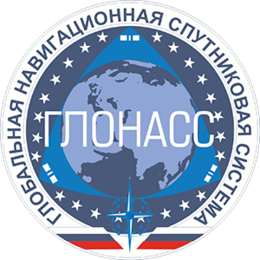You can help expand this article with text translated from the corresponding article in Russian. (October 2023) Click [show] for important translation instructions.
|
 GLONASS logo | |
| Country/ies of origin | (now |
|---|---|
| Operator(s) | Roscosmos ( |
| Type | Military, civilian |
| Status | Operational |
| Coverage | Global |
| Accuracy | 2.8–7.38 metres |
| Constellation size | |
| Nominal satellites | 24 |
| Current usable satellites | 26 |
| First launch | October 12, 1982 |
| Last launch | 7 August 2023 |
| Orbital characteristics | |
| Regime(s) | 3 × MEO planes |
| Orbital height | 19,130 km |
| Orbital period | 8⁄17 sd, 11 hours and 16 minutes |
| Revisit period | 8 sidereal days |
| Website | glonass-iac.ru/en |
GLONASS (ГЛОНАСС, IPA: [ɡɫɐˈnas]; Russian: Глобальная навигационная спутниковая система, romanized: Global'naya Navigatsionnaya Sputnikovaya Sistema, lit. 'Global Navigation Satellite System') is a Russian satellite navigation system operating as part of a radionavigation-satellite service. It provides an alternative to Global Positioning System (GPS) and is the second navigational system in operation with global coverage and of comparable precision.
Satellite navigation devices supporting both GPS and GLONASS have more satellites available, meaning positions can be fixed more quickly and accurately, especially in built-up areas where buildings may obscure the view to some satellites.[1][2][3] Owing to its higher orbital inclination, GLONASS supplementation of GPS systems also improves positioning in high latitudes (near the poles).[4]
Development of GLONASS began in the Soviet Union in 1976. Beginning on 12 October 1982, numerous rocket launches added satellites to the system until the completion of the constellation in 1995. In 2001, after a decline in capacity during the late 1990s, the restoration of the system was made a government priority, and funding increased substantially. GLONASS is the most expensive program of the Roscosmos, consuming a third of its budget in 2010.
By 2010, GLONASS had achieved full coverage of Russia's territory. In October 2011, the full orbital constellation of 24 satellites was restored, enabling full global coverage. The GLONASS satellites' designs have undergone several upgrades, with the latest version, GLONASS-K2, launched in 2023.[5]
- ^ Angrisano, A.; Petovello, M.; Pugliano, G. (2012). "Benefits of combined GPS/GLONASS with low-cost MEMS IMUs for vehicular urban navigation". Sensors. 12 (4): 5134–5158. Bibcode:2012Senso..12.5134A. doi:10.3390/s120405134. PMC 3355462. PMID 22666079.
- ^ "GLONASS significantly benefits GPS". 15 September 2010. Archived from the original on 15 November 2017. Retrieved 7 October 2017.
- ^ "Developer Tools - Sony Developer World". sonymobile.com. Archived from the original on 29 December 2014. Retrieved 7 October 2017.
- ^ "GPS, GLONASS, and More" (PDF). University of New Brunswick. Archived (PDF) from the original on 30 April 2018.
Figure 2 shows the PDOP improvement in percentage when comparing the GPS-only to the GPS-plus-GLONASS PDOP values. At high latitudes, that is, above 55°, the improvement is at the 30% level.
- ^ Hendrickx, Bart (19 December 2022). "The secret payloads of Russia's Glonass navigation satellites". The Space Review. Archived from the original on 20 December 2022. Retrieved 20 December 2022.